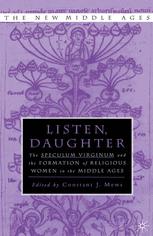

Most ebook files are in PDF format, so you can easily read them using various software such as Foxit Reader or directly on the Google Chrome browser.
Some ebook files are released by publishers in other formats such as .awz, .mobi, .epub, .fb2, etc. You may need to install specific software to read these formats on mobile/PC, such as Calibre.
Please read the tutorial at this link: https://ebookbell.com/faq
We offer FREE conversion to the popular formats you request; however, this may take some time. Therefore, right after payment, please email us, and we will try to provide the service as quickly as possible.
For some exceptional file formats or broken links (if any), please refrain from opening any disputes. Instead, email us first, and we will try to assist within a maximum of 6 hours.
EbookBell Team

4.0
76 reviewsThe words 'Listen daughter' (Audi filia, from Psalm 44 in the Latin Vulgate) were frequently used in exhortations to religious women in the twelfth century. This was a period of dramatic growth in the involvement of women in various forms of religious life. While Hildegard of Bingen (1098-1179) has become widely known in recent years as one of the most eloquent and original voices of the period, she is often seen as a figure in isolation from her context. She lived at a time of much questioning of traditional models of religious life, by women as well as by men. This volume introduces readers to a range of strategies provoked by the growth in women's participation in religious life in one form or another, as well as to male responses to this development. In particular, it looks at the 'Mirror for Virgins' (Speculum Virginum), an illustrated dialogue between a nun and her spiritual mentor written by a monk not long before Hildegard started to record her visions. While this treatise engages in dialogue with a fictional virgin, other writings present women (not just Hildegard) as teaching both women and men. An appendix will provide the first English translation of significant excerpts from the Speculum, as well as from other little known texts about religious women from the age of Hildegard. The underlying concern of this volume is to examine new ways in which religious life for women was conceived by men as well as interpreted in practice by women within a society firmly patriarchal in character.